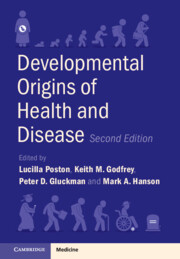Book contents
- Developmental Origins of Health and Disease
- Developmental Origins of Health and Disease
- Copyright page
- Contents
- Contributors
- Preface
- Section I Overview
- Section II Exposures Driving Long-Term DOHaD Effects
- Section III Outcomes
- Section IV Mechanisms
- Chapter 14 Visualizing Structural Underpinnings of DOHaD
- Chapter 15 Molecular and Epigenetic Mechanisms of DOHaD
- Chapter 16 The Role of the Placenta in DOHaD
- Section V Interventions
- Section VI Public Health and Policy Implications of Interventions
- Index
- References
Chapter 16 - The Role of the Placenta in DOHaD
from Section IV - Mechanisms
Published online by Cambridge University Press: 01 December 2022
- Developmental Origins of Health and Disease
- Developmental Origins of Health and Disease
- Copyright page
- Contents
- Contributors
- Preface
- Section I Overview
- Section II Exposures Driving Long-Term DOHaD Effects
- Section III Outcomes
- Section IV Mechanisms
- Chapter 14 Visualizing Structural Underpinnings of DOHaD
- Chapter 15 Molecular and Epigenetic Mechanisms of DOHaD
- Chapter 16 The Role of the Placenta in DOHaD
- Section V Interventions
- Section VI Public Health and Policy Implications of Interventions
- Index
- References
Summary
Placental function supports the growth and development of the fetus by providing nutrients, removing fetal waste and protecting the fetus from xenobiotics. The placenta also secretes hormones and other endocrine mediators that adapt maternal physiology to support the pregnancy. Where placental function is inadequate, fetal development may be compromised and result in persistent changes in organ structure and function that have consequences for later health.
- Type
- Chapter
- Information
- Developmental Origins of Health and Disease , pp. 166 - 175Publisher: Cambridge University PressPrint publication year: 2022



